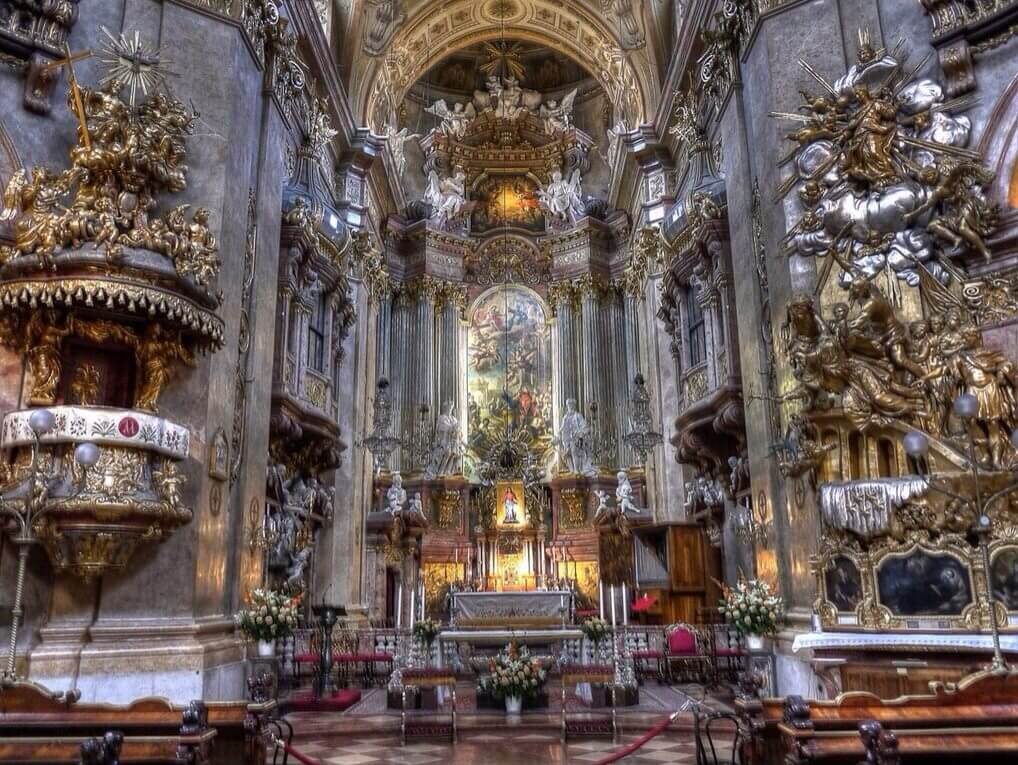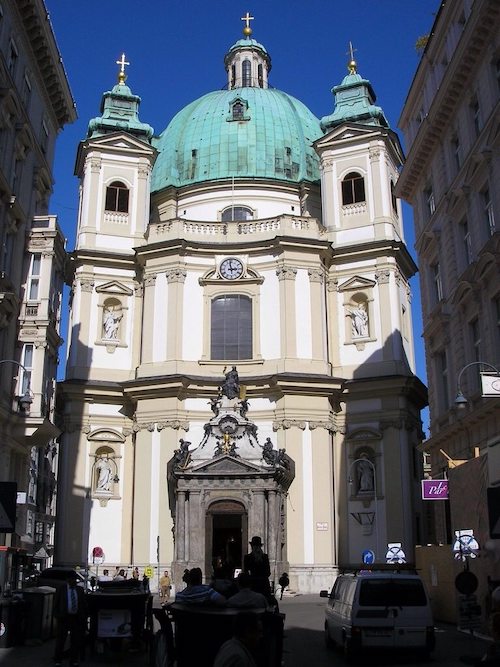
On our way to Stephansdom we ran into this beautiful church right in the middle of the street, traffic and horse drawn carriages go around it on both sides. Peterskirche (Saint Peter’s Church) is a Baroque Roman Catholic parish church in Vienna. It was transferred in 1970 by the Archbishop of Vienna, Franz Cardinal König, to the priests of the Opus Dei. The medieval church had three altars, with an apse in the south instead of the normal eastern orientation. This unusual feature has triggered many discussions among experts, and it is suspected that the church was adapted from a previously secular building. The church was, and still is, surrounded by shops. The old church burned down in 1661 and was given only makeshift repairs. The decision to build a new church was taken up with the arrival of the Fraternity of the Holy Trinity of which the emperor Leopold I was a member. He had taken a vow to rebuild this church when Vienna was ravaged by the plague in 1679-1680.
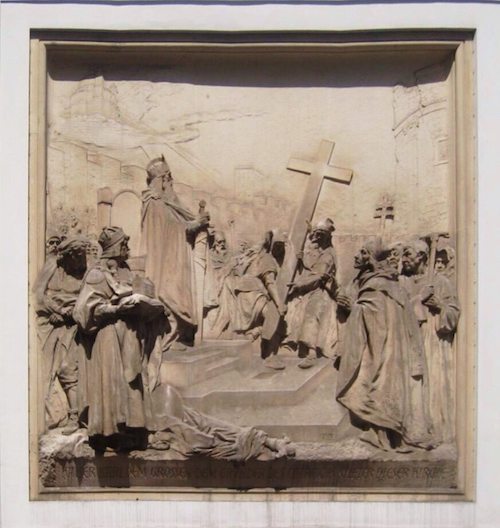
The oldest church building (of which nothing remains today) dates back to the Early Middle Ages, and there is speculation that it could be the oldest church in Vienna. That Roman church was built on the site of a Roman encampment under the name Vindobona. The next church was replaced with a Romanesque church with a nave and two aisles. It is believed to have been established by Charlemagne around 800, although there is no evidence supporting this view. On the outside of the present church, there is a relief sculpture by R. Weyr consecrated to the founding of the church by Charlemagne. The text beneath says: (Dedicated to) Emperor Charlemagne, the founder of the eastern empire – the sponsor of this church. Interestingly enough you can see the old church from that time to the right, while to the left there is a baroque church, as it looks today, floating in the sky. This foundation by Charlemagne can very well be just a legend. In any case, the first written reference about Saint Peter’s church in Vienna dates back to the year 1137.
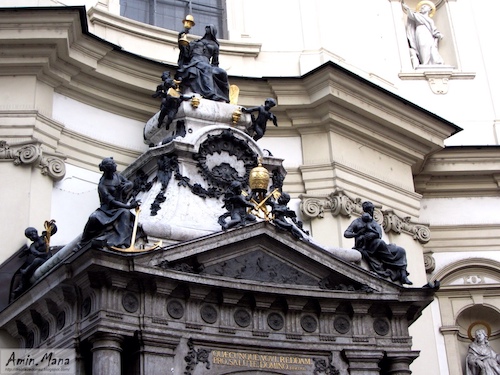
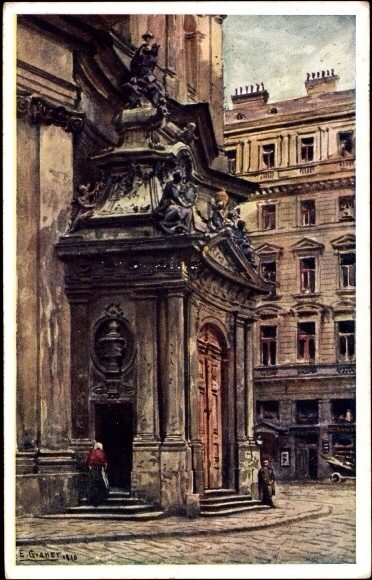
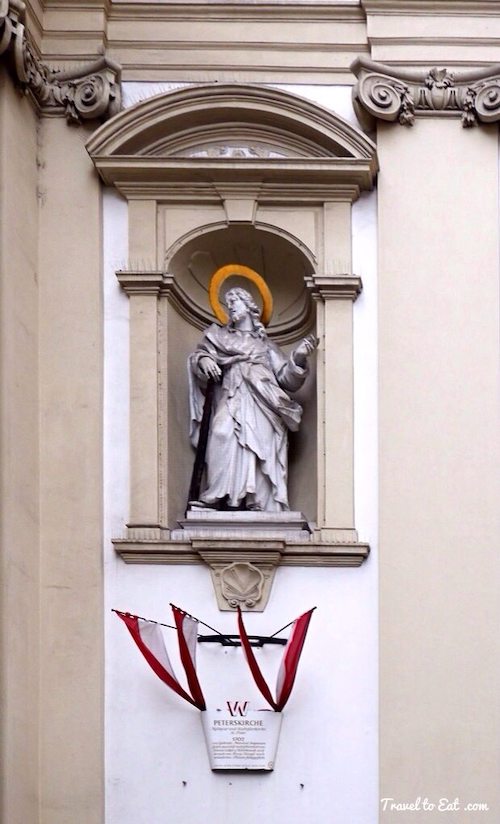
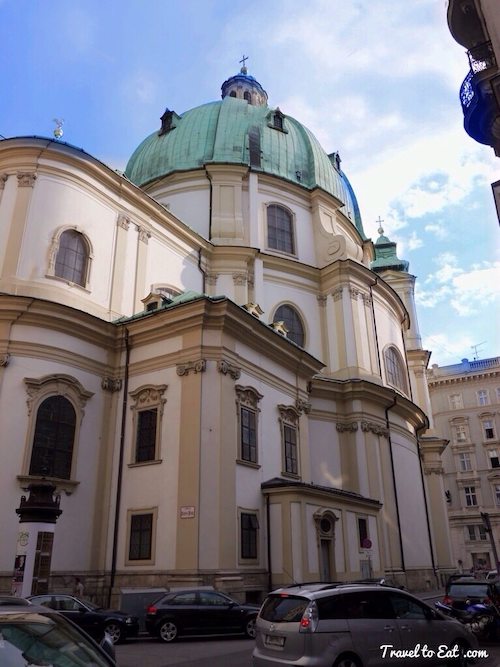
The construction of the new Baroque church was begun around 1701 under Gabriele Montani, who was replaced by Johann Lukas von Hildebrandt in 1703. The design was inspired by the St. Peter’s Basilica of the Vatican in Rome. By 1722, most of the building was finished, and in 1733, the Peterskirche was finally consecrated to the Holy Trinity. It is the most lavishly decorated baroque church in Vienna. The facade has angled towers, graceful turrets (said to have been inspired by the tents of the Turks during the siege of 1683), and an unusually fine entrance portal. The Rococo portal was designed by Andrea Altomonte and executed by Georg Joachim Schwandtner. On its roof, the three theological virtues of faith, hope and love as lead statues (of Franz Kohl, inspired by Figure inventions by Georg Raphael Donner) are shown.
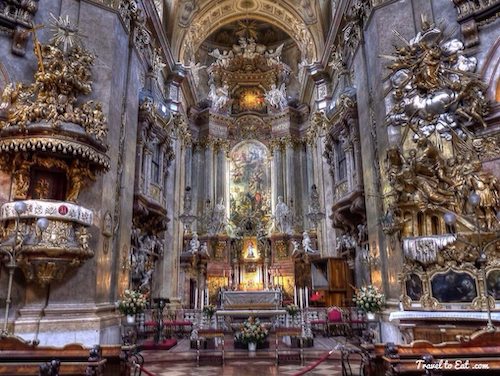
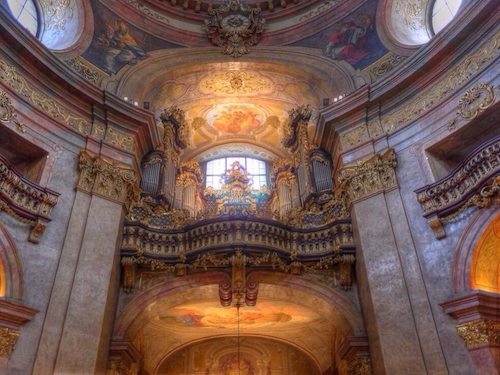

The new church was the first domed structure in Baroque Vienna. Due to the confinement of available space, it was built in a very compact form, with its oval interior housing an astonishing amount of space and rectangular attachments. As you walk in the door, the church makes an overwhelming impression with its surprisingly rich Baroque interior filled with golden stucco. The high Baroque altar was created by Santino Bussi after a design by Antonio Galli, a member of the Galli-Bibiena family, a family of 17th and 18th century Italian artists. Galli was also responsible for the trompe-l’oeil above the high altar. The altarpiece portrays the Healing of the Lame by St. Peter and St. John in Jerusalem by Martino Altomonte (1657–1745). The small painting of the Immaculate Conception above the high altar is by the 19th century artist Kupelwieser.
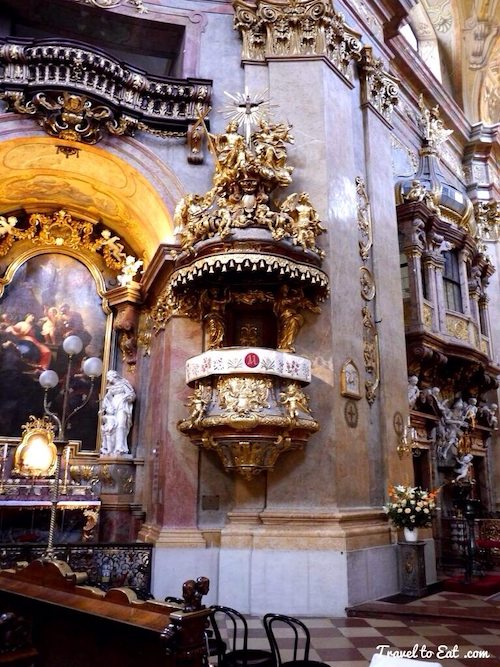

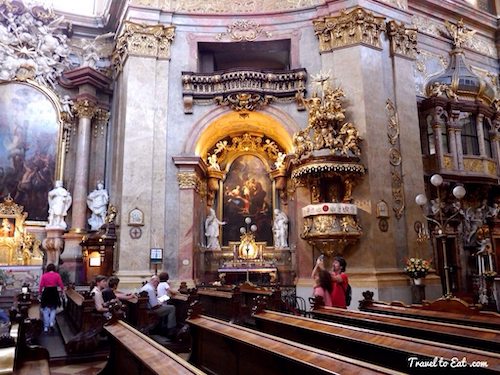
The gilded ornate pulpit is a magnificent sculpture by Matthias Steinl (1726) with a representation of the holy trinity on top of the canopy. Opposite the pulpit, there is a dramatic gold-and-silver representation of the Martyrdom of St. John of Nepomuk, sculpted by Lorenzo Mattielli in 1729. The gilded sculptures depict martyr Saint John Nepomuk being thrown off the Charles Bridge in Prague. On top of it is a beautiful statue of Mary, “The Mother of God”. Theotokos is the Greek title of Mary, the mother of Jesus used especially in the Eastern Orthodox, Oriental Orthodox, and Eastern Catholic Churches. Its literal English translations include “God-bearer”, “Birth-Giver of God” and “the one who gives birth to God.” Less literal translations include “Mother of God.” The Council of Ephesus decreed in 431 that Mary is Theotokos because her son Jesus is both God and man: one Divine Person with two natures (Divine and human) intimately, hypostatically united.
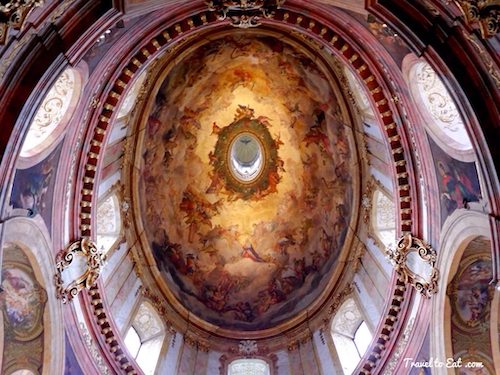
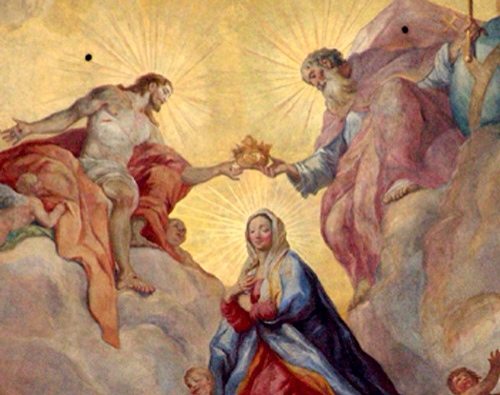
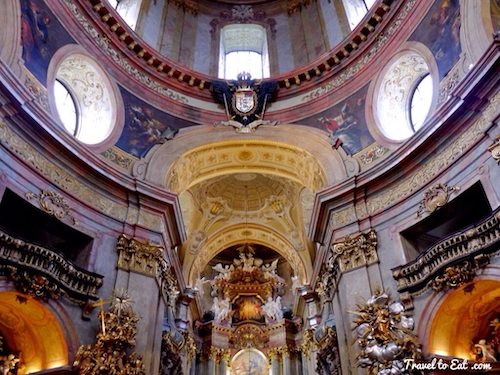

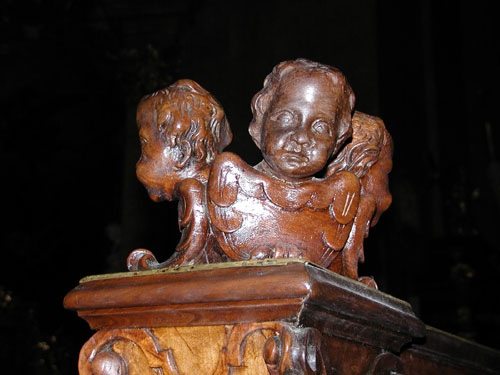
The turreted dome was mainly designed by Matthias Steinl, who was also responsible for the interior decoration and the pews with their famous cherubic heads. The frescoes were originally painted by the famous Italian Andrea Pozzo, whose paintings were removed after his death. As a result, in 1713, Johann Michael Rottmayr was able to start a completely new set. The fresco in the cupola represents the Coronation of Our Lady. On the triumphal arch one can see the coat of arms of emperor Leopold I. In the spandrels around the dome are portrayals of the four Evangelists and four Fathers of the Church, painted by the Viennese artist J.G. Schmidt. The same artist also painted the altarpiece in the side chapel of St. Michael.
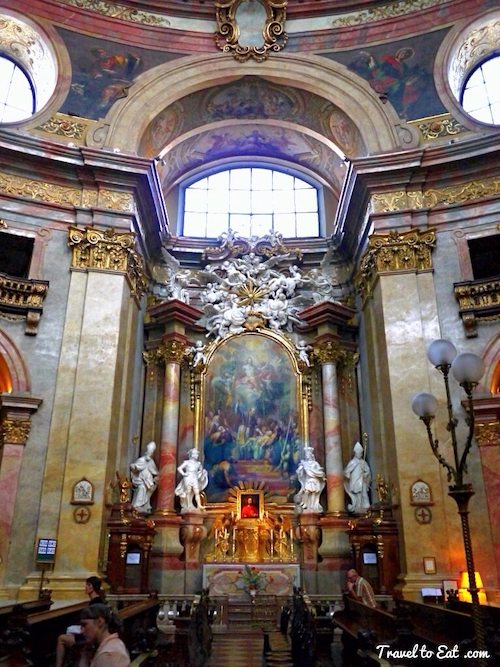
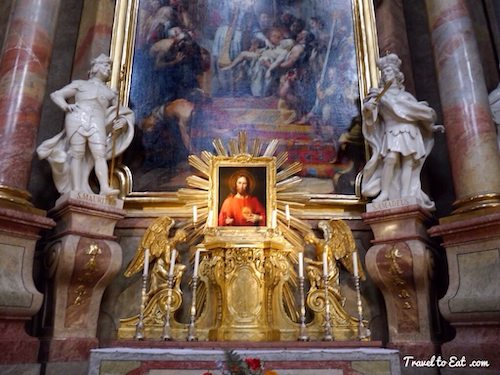
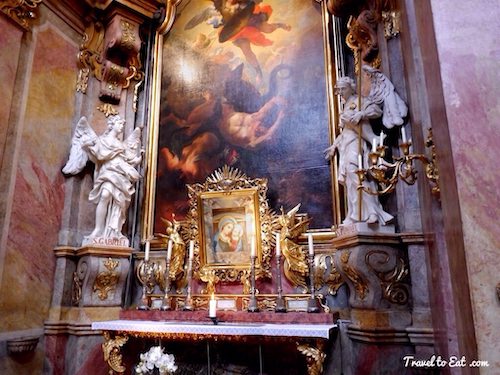
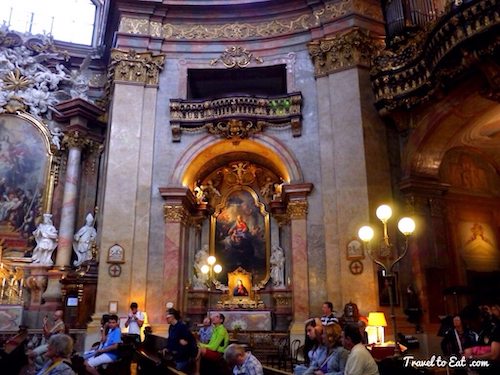
Around the edges of the nave are side chapels flanked with white porcelain statuettes of Saints and Angels. Just about every surface in the church is painted, gilded or covered with marble. From 1998 to 2004, the church underwent a renovation, which returned the paintings to their original rich colouring and brightness. This really was one of the most beautiful churches I have seen, and I have seen quite a few. It is definitely a must visit in Vienna.
References:
Official Website: http://www.peterskirche.at/home/
Saint Peters Church Layout: http://www.peterskirche.at/fileadmin/pdf/tourismusinfo/englisch.pdf
Opus Dei: http://www.opusdei.org

